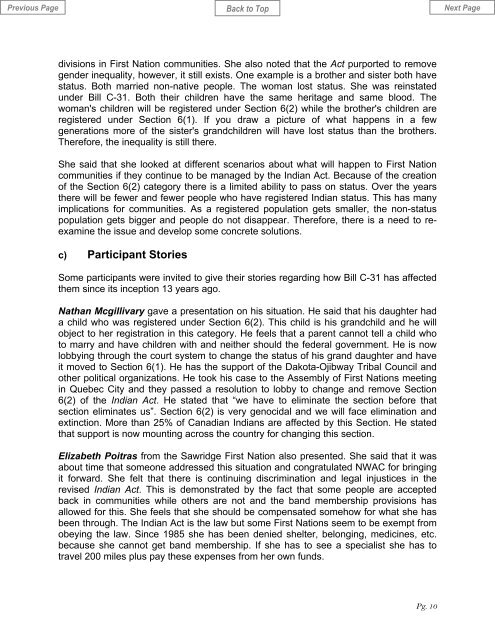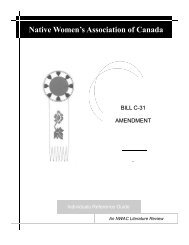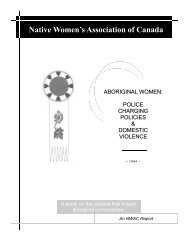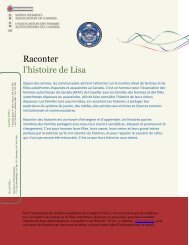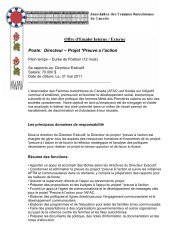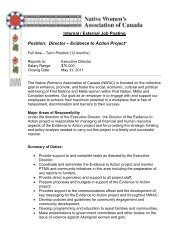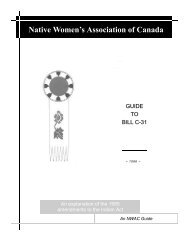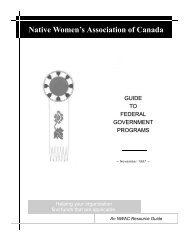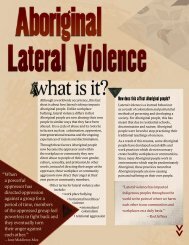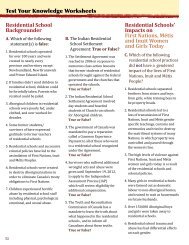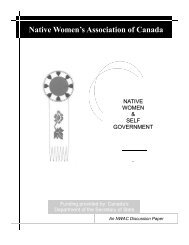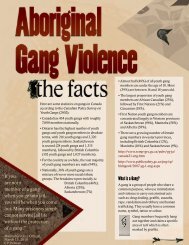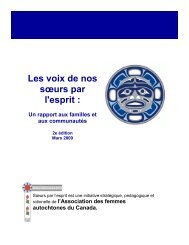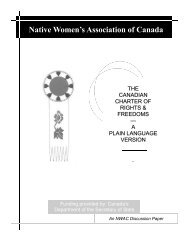BILL C-31 - Native Women's Association of Canada Website
BILL C-31 - Native Women's Association of Canada Website
BILL C-31 - Native Women's Association of Canada Website
- No tags were found...
Create successful ePaper yourself
Turn your PDF publications into a flip-book with our unique Google optimized e-Paper software.
divisions in First Nation communities. She also noted that the Act purported to removegender inequality, however, it still exists. One example is a brother and sister both havestatus. Both married non-native people. The woman lost status. She was reinstatedunder Bill C-<strong>31</strong>. Both their children have the same heritage and same blood. Thewoman's children will be registered under Section 6(2) while the brother's children areregistered under Section 6(1). If you draw a picture <strong>of</strong> what happens in a fewgenerations more <strong>of</strong> the sister's grandchildren will have lost status than the brothers.Therefore, the inequality is still there.She said that she looked at different scenarios about what will happen to First Nationcommunities if they continue to be managed by the Indian Act. Because <strong>of</strong> the creation<strong>of</strong> the Section 6(2) category there is a limited ability to pass on status. Over the yearsthere will be fewer and fewer people who have registered Indian status. This has manyimplications for communities. As a registered population gets smaller, the non-statuspopulation gets bigger and people do not disappear. Therefore, there is a need to reexaminethe issue and develop some concrete solutions.c) Participant StoriesSome participants were invited to give their stories regarding how Bill C-<strong>31</strong> has affectedthem since its inception 13 years ago.Nathan Mcgillivary gave a presentation on his situation. He said that his daughter hada child who was registered under Section 6(2). This child is his grandchild and he willobject to her registration in this category. He feels that a parent cannot tell a child whoto marry and have children with and neither should the federal government. He is nowlobbying through the court system to change the status <strong>of</strong> his grand daughter and haveit moved to Section 6(1). He has the support <strong>of</strong> the Dakota-Ojibway Tribal Council andother political organizations. He took his case to the Assembly <strong>of</strong> First Nations meetingin Quebec City and they passed a resolution to lobby to change and remove Section6(2) <strong>of</strong> the Indian Act. He stated that “we have to eliminate the section before thatsection eliminates us”. Section 6(2) is very genocidal and we will face elimination andextinction. More than 25% <strong>of</strong> Canadian Indians are affected by this Section. He statedthat support is now mounting across the country for changing this section.Elizabeth Poitras from the Sawridge First Nation also presented. She said that it wasabout time that someone addressed this situation and congratulated NWAC for bringingit forward. She felt that there is continuing discrimination and legal injustices in therevised Indian Act. This is demonstrated by the fact that some people are acceptedback in communities while others are not and the band membership provisions hasallowed for this. She feels that she should be compensated somehow for what she hasbeen through. The Indian Act is the law but some First Nations seem to be exempt fromobeying the law. Since 1985 she has been denied shelter, belonging, medicines, etc.because she cannot get band membership. If she has to see a specialist she has totravel 200 miles plus pay these expenses from her own funds.Pg. 10


